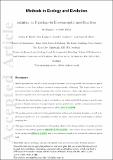inlabru : an R package for Bayesian spatial modelling from ecological survey data
Abstract
1. Spatial processes are central to many ecological processes, but fitting models that incorporate spatial correlation to data from ecological surveys is computationally challenging. This is particularly true of point pattern data (in which the primary data are the locations at which target species are found), but also true of gridded data, and of georeferenced samples from continuous spatial fields. 2. We describe here the R package inlabru that builds on the widely-used R-INLA package to provide easier access to Bayesian inference from spatial point process, spatial count, gridded, and georeferenced data, using integrated nested Laplace approximation (INLA, Rue et al., 2009). 3. The package povides methods for fitting spatial density surfaces and estimating abundance, as well as for plotting and prediction. It accommodates data that are points, counts, georeferenced samples, or distance sampling data. 4. This paper describes the main features of the package, illustrated by fitting models to the gorilla nest data contained in the package spatstat (Baddeley & Turner, 2005), a line transect survey data set contained in the package dsm (Miller et al., 2018), and to a georeferenced sample from a simulated continuous spatial field.
Citation
Bachl , F E , Lindgren , F , Borchers , D L & Illian , J B 2019 , ' inlabru : an R package for Bayesian spatial modelling from ecological survey data ' , Methods in Ecology and Evolution , vol. 10 , no. 6 , pp. 760-766 . https://doi.org/10.1111/2041-210X.13168
Publication
Methods in Ecology and Evolution
Status
Peer reviewed
ISSN
2041-210XType
Journal article
Description
This research was funded by EPSRC grants EP/K041061/1, EP/K041053/1, and EP/K041053/2.Collections
Items in the St Andrews Research Repository are protected by copyright, with all rights reserved, unless otherwise indicated.

